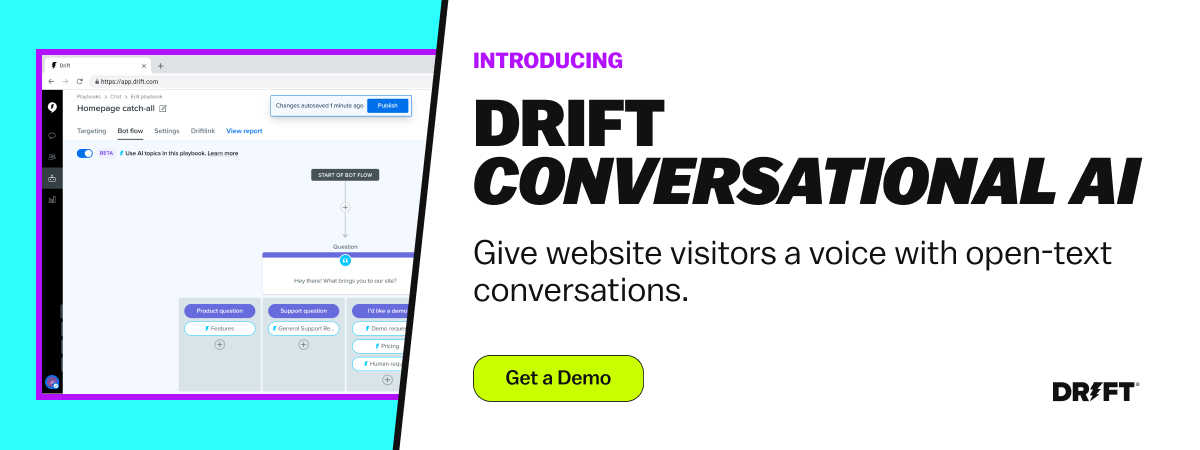In our digital world, we see ads everywhere.
But often these ads are not relevant to us as buyers. Like getting an ad for a dating app when you’re happily married. Or a meat delivery service when you’re vegan. Or a tractor when you live in the city.
You get the idea.
This lack of personalization is leading to missed opportunities. In 2021, buyer expectations for quick, personalized experiences grew by 26% in a single year. And with the imminent demise of third-party cookies, this kind of personalization is going to get much harder.
Unless we embrace the future of AI marketing.
That’s precisely what the team at Quantcast is doing — by offering an intelligent audience platform that helps companies deliver real-time advertising.
In the pilot episode of Revenue Talks, hosts Katie Foote and Justin Keller spoke with Ingrid Burton, former CMO of Quantcast, to learn about how AI marketing is changing the personalization game and setting up marketers for success in a cookieless world.
Here’s what she had to say 👇
What Is AI Marketing?
When we talk about AI, some people inevitably jump to the conclusion that AI will (sooner or later) eliminate the need for human workers. But that’s just not true.
In fact, AI cannot take away our jobs because, as Ingrid puts it, “Artificial intelligence is an umbrella term for augmenting human intelligence. It isn’t to replace humans. It’s to augment us.”
While AI can refer to any number of technologies, AI marketing helps businesses make more informed decisions to better serve their buyers. And it’s because AI marketing done right relies on first-party data, not third-party data.
Unlike third-party data, first-party data comes straight from the source. It is information your buyers willingly share with you. So, with AI, you can draw on accurate, up-to-date information to analyze patterns of behavior, make predictions, and improve your marketing campaigns.
Not only is AI marketing essential if you want to tailor the buying experience — it’s also exactly what your customers want. Accenture found that 83% of consumers are willing to share their data to enable personalized experiences. And solutions like Drift’s Conversational AI can help you collect this data without making your buyers feel like they’re being spied on.
Check out how Drift’s Conversational AI serves up the right experience at the right time for all your customers.
To Ingrid, it’s clear that AI marketing will be a part of our future: “For marketing people, you have to invest in AI techniques or look at vendors that use AI in order to ascertain who’s coming to your site, who wants this, who’s looking… We have our gut feel, our intuition, but we need the data.”
3 Best Practices for Effective AI Marketing
Before you start worrying about taking a crash course in machine learning or the cost of hiring a team of data analysts, consider this: You don’t have to be an AI expert to use it effectively.
However, you do have to be wary of putting everything in the AI’s hands. Ingrid warns that it’s not “the big bandaid that’s going to find you leads or…new customers. It’s just another tool in your toolbox.”
As with all tools, there are certain practices that will help you garner the best results. Here are three tips to keep in mind 👇
1. Take Your Data with a Grain of Salt
The most important thing to keep in mind is that while AI is useful, it isn’t infallible. The conclusions it might draw may be biased or untrue, depending on the data it uses.
That’s where marketers come in.
When it comes to AI, don’t blindly accept the insights that are handed to you. Instead, think about where the data is coming from and what it is saying. Examine your results and check that they make sense. If they don’t, chances are your model has some unconscious bias — and you may be excluding a particular demographic or subset of potential buyers.
In short, AI should augment what you think you already know. And if the results surprise you, as Ingrid sums up, “You should investigate. You should really make sure.”
2. Ask the Right Questions for the Right Results
As we’ve said, AI is a valuable tool for sifting through buyer data…but that’s only if you ask it the right questions. You can’t ask the AI broad, open-ended questions and expect to get a clear answer.
A good question is both time-bound and metric-bound — and it gets to the heart of the problem you’re looking to solve. Hone in on what you want to learn most about your buyers. As a marketer, you might ask, “Is this buyer qualified?” or “What other products might this customer be interested in?”
With the right question in play, you can create models based on previous customer data to predict how buyers in similar industries or verticals will behave. These insights will then help you tailor your marketing campaigns to your ideal customers.
3. Follow the Customer Journey
What’s the golden rule for creating personalized experiences? Always go back to the customer journey.
In today’s always-on economy, buyers don’t just want personalized experiences when they are ready to buy. They expect personalization throughout the entire journey — whether they just started researching your company or they’ve been a longtime customer.
When you use the customer journey as a roadmap, you can pinpoint what your customers want at every touchpoint. Ingrid’s team does this by using AI to scour for patterns of behavior among similar customers, such as companies in the same industry.
With this data, your team can get into the weeds with your campaigns — tailoring ad copy or serving up curated content to funnel your buyers further along the customer journey.
You Bring the Art, AI Will Bring the Science
At Drift, we like to say that marketing is both an art and a science. Marketers need to come up with creative ways to engage buyers and deliver the personalized experiences they want. But to do that, they also need data.
In a cookieless world, AI will empower marketers to create better buying experiences.
And, as Ingrid emphasizes, implementing AI isn’t as daunting as it sounds. It boils down to understanding the problems you want to solve and putting the right tool in place. So even if you don’t reinvent the marketing wheel, with AI, you can build smarter and more creative campaigns that convert.











